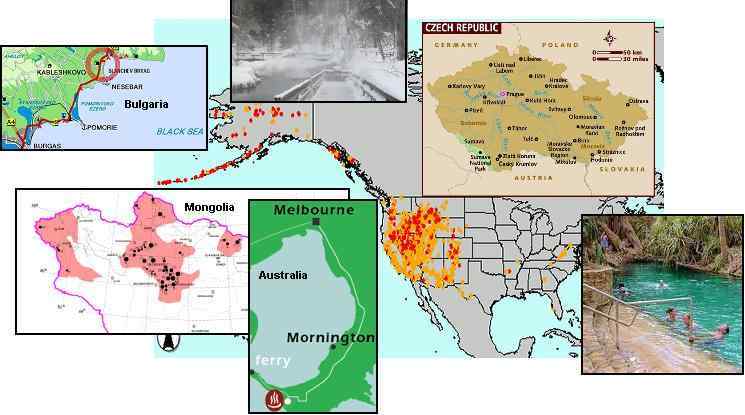
 Hot Springs
Hot Springs
In analyzing an area for relative safety during the coming pole shift, and for habitability in the Aftertime, there are several steps that should be taken. In all of these
cautions, there are of course exceptions.
- The first to consider is whether the area will be viable at all for a ride through the pole shift. India will go under the waves, as will western Australia.
Indonesia, except for the high mountains in Borneo, will be iffy for survival at all, as will be true in Central America and the Caribbean and Florida. But it is
theoretically possible for someone to survive the rough water and disappearing land, to stay afloat or be on a high peak that remains above the waves.
- Next is to consider where the new poles will be located, and the distance of the safe location from a new pole. Considering northern Siberia, northern
Canada, Iceland and the northern reaches of Norway, Sweden and Finland as representative lands near a pole, consider whether a survival community could
sustain itself in such a place. But it would be possible to survive in Tibet and then migrate toward Alaska after the pole shift, for instance, or survive the pole
shift in the Bulge of Brazil and migrate toward the new Equator off the Andes.
- Next is whether the area is a mountain building zone. The Andes, the West Coast of the US and Canada, the Aleutian Islands, Kamchatka in Russia and
Japan - all will sustain subduction with consequent mountain building. But in such areas there are hard rock plateaus that have withstood pressure in the past
that could be considered safe for a ride through the pole shift. We have also stated that the mountains in the eastern US, the Alps, and in eastern Russia and
Mongolia and China are not in a mountain building state, but in a stretch zone. These are safe zones.
- Then there is the issue of volcanic zones, which most often are located in mountain building areas. Volcanoes edge the Ring of Fire, and for the same reason
that mountain building can be expected in these areas, volcanic eruptions from any volcano which has erupted in the past 10,000 years should be expected.
But not all volcanoes expected to erupt will do so violently. Yellowstone or the Hawaii volcanoes where rock layers are folding under them will be less
explosive than assumed.
- Then there is the issue of tidal waves, which will roll inland in some areas for hundreds of miles and at great height. Texas will be scoured to the Escarpment,
and the southern coast of Brazil flooded over the coastal mountains. The general guide is to be 100 miles inland and 200 feet high. But survival along
coastlines is possible if above 600 feet and tidal bore or special circumstances are taken into consideration.
- Then there is the issue of hot or melting Earth, where subduction in river valleys is so rapid and aggressive that the heat melts the ground, as has been
recorded by the West Coast Indians in the past. The eastern Mediterranean coastline also recorded this during the Exodus. But being on high ground is a
guard against hot or melting Earth, as the rock only melts when it is close to the point of friction between rock layers.
- Then there is the matter of hot springs or places where the Earth is so thin that magma is near the surface. These have the potential during the pole shift of
releasing gasses and ash, in the worst case being the equivalent of a volcanic eruption. This is more likely in a subduction zone such as the West Coast of the
US. But hot springs will only be a danger in areas where violent subduction or violent stretching occurs, such as in the Rift Valley in Africa. Danger in the
Alps or in Mongolia is virtually nil.
- Next is proximity to flooding rivers, which will all top their banks. Such floods can spread in the interior of a continent for vast areas, melting the soil under
buildings and toppling them and leaving survivors floating in an inland sea. But interior flooding from rivers overtopping their banks can be survived if one is in
high ground well above the flood level of nearby rivers. Double the worst flood on record as a guide and be on rock, not soil that can melt.
ZetaTalk ™ June 11, 2011




![]()
